Feeding blue tongue skinks with the right diet is critical. To offer proper nutrition, you need to understand their nutritional requirements.
Most people don’t know what to feed their blue tongue skink. Also, they don’t remember the nutritional requirement of BTS at every stage. For this reason, they feed their skinks with the wrong diet. Some even supply them with toxic foods that cause death.
In this article, we give you a detailed diet plan for the baby skink, adult skink, and even juvenile skink. We will also provide you with mineral supplements breakdown.
Like humans and any other animals, a healthy diet is vital for your blue tongue skinks’ health. It is, therefore, critical to keenly follow this diet plan for your blue tongue skink.
This article has been reviewed by Dr. Dilber. Read more about our knowledge control process here.
Contents
- Blue Tongue Skink Diet List: What Do Blue Tongue Skinks Eat?
- Blue Tongue Skink Diet in the Wild
- Baby Blue Tongue Skink Diet
- Juvenile Blue Tongue Skink Diet
- Adult Blue Tongue Skink Diet
- Blue Tongue Skink by Age
- How to Transition a Blue Tongue Skink to a New Diet
- What Not to Feed Your Blue Tongue Skink
- Wrapping Up Blue Tongue Skink Diet
Blue Tongue Skink Diet List: What Do Blue Tongue Skinks Eat?
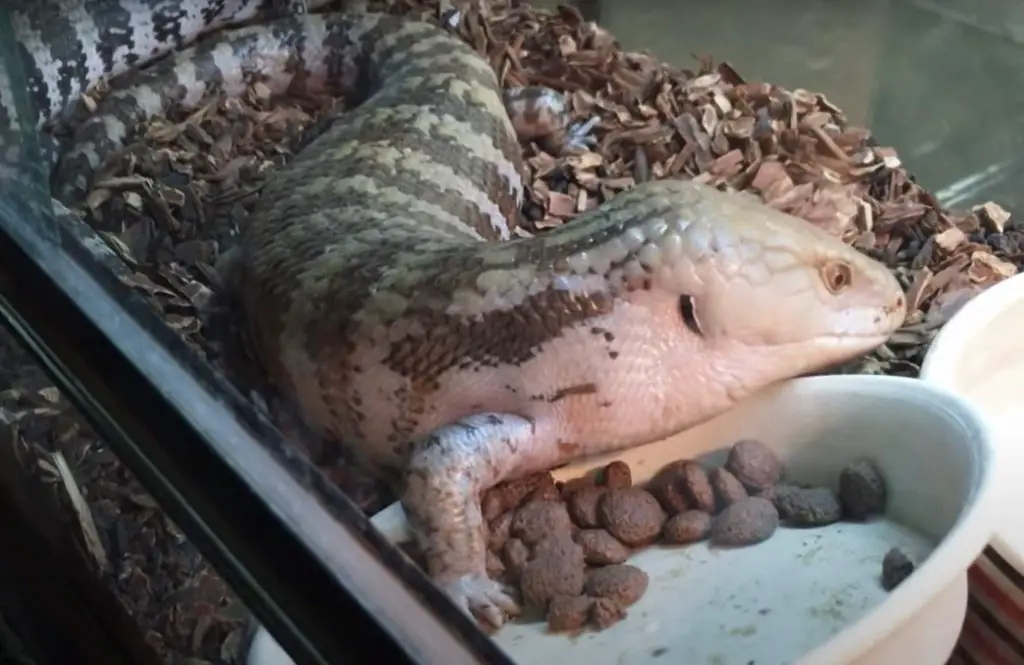
Blue tongue skinks need to feed on a balanced diet. Therefore, their diet should include proteins, carbs, vitamins, and minerals.
Their diet comprises meat, insects, vegetables, fruits, and mineral supplements. Nutritional problems are the primary cause of blue tongue skinks sickness in captivity. For this reason, it is critical to ensure that you feed your BTS with a proper diet.
Additionally, if you cannot take your BTS to bask in direct sunlight, you should provide it with vitamin D3. UVB lighting, even though it is good for the BTS in captivity, it does not provide enough vitamin D3. It is, therefore, necessary to include vitamin D3 supplements in your BTS diet.
Let’s now break down your blue tongue skink diet.
What Fruits Can Blue Tongue Skinks Eat?
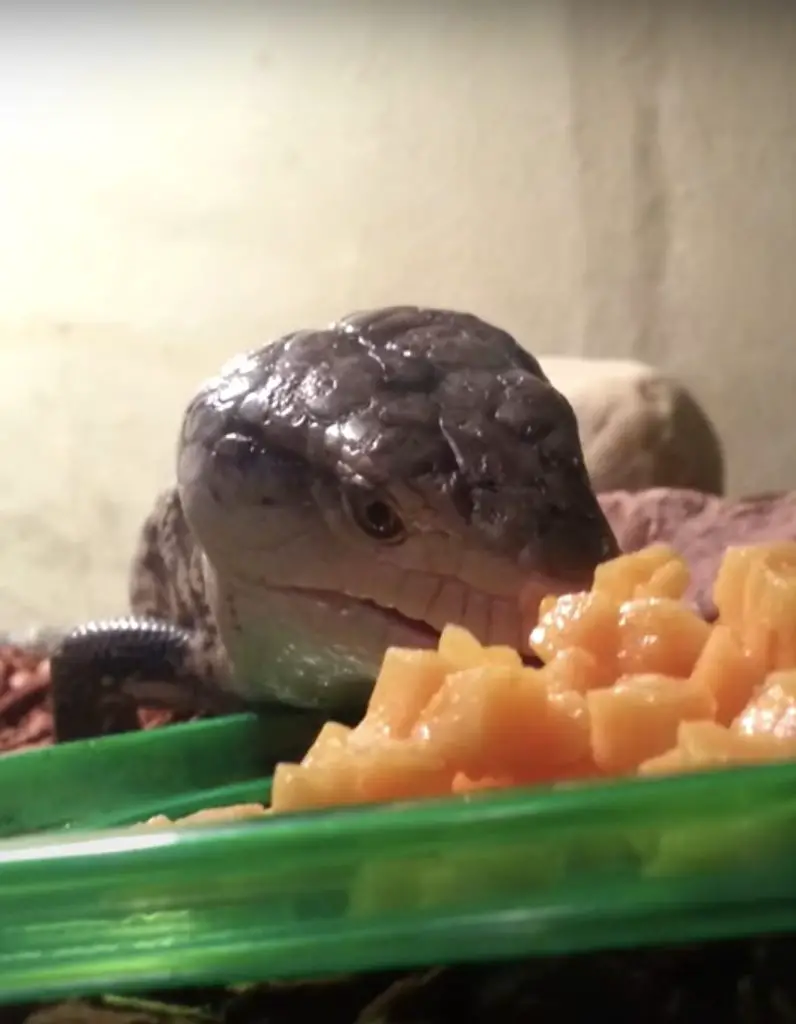
Fruits are high in calcium and phosphorus. They are, therefore, necessary in your blue tongue skink’s diet. However, blue tongue skinks only require 10% of fruits in their diet. Thus, you should give fruits to blue tongue skinks as a treat.
It is worth noting that not all fruits are suitable for your blue tongue skink. Therefore, we came up with a table showing you the best fruits to feed your BTS.
| Name | Ratio Ca:P | Protein % | Fat% | Feed | Notes |
| Kiwi | 1:1.5 | 1.0 | 0.4 | Occasionally | |
| Bananas | 1:3.3 | 1.0 | 0.5 | Occasionally | |
| Blueberries | 1:1.6 | 0.7 | 0.4 | Occasionally | |
| Cherries | 1:1.6 | 1.1 | 0.2 | Occasionally | |
| Guava | 1:1.3 | 0.8 | 0.6 | Occasionally | |
| Grapes | 1.4:1 | 0.6 | 0.4 | Occasionally | |
| Apple | 1:1.8 | 0.2 | 0.3 | Occasionally | |
| Fig | 2.5:1 | 0.8 | 0.3 | Moderately | |
| Papaya | 5:1 | 0.6 | 0.1 | Moderately | High Vitamins |
| Pineapple | 1:1 | 0.4 | 0.4 | Occasionally | |
| Watermelon | 1:1 | 0.6 | 0.4 | Occasionally | |
| Strawberries | 1:1.4 | 0.6 | 0.4 | Occasionally | High vitamin C |
| Mango | 1:1 | 0.5 | 0.3 | Moderately | High Vitamin A |
| Pear | 1:1 | 0.4 | 0.4 | Occasionally | |
| Pomegranate | 1:1.2 | 1.0 | 0.3 | Occasionally | High Oxalates |
| Star fruit | 1:4 | 0.5 | 0.4 | Occasional | High oxalates |
| Raspberries | 1:1.2 | 0.9 | 0.6 | Moderately | Moderate oxalates |
| Plums | 1:2.5 | 0.8 | 0.6 | Occasionally | |
| Nectarines | 1:3 | 0.9 | 0.5 | Occasionally | |
| Cranberries | 1:1.3 | 0.4 | 0.2 | Occasionally |
NB
Never feed your blue tongue skink with avocados. They contain persin, which is a toxin harmful to blue tongue skinks.
What Vegetables can Blue Tongue Skinks Eat?
Vegetables are a good source of vitamins. Adult blue tongue skinks require at least 40-50% of vegetables, while babies require 20-30%. It is, therefore, critical to get enough vegetables for your skink.
You should grate or use a food processor for hard vegetables or a knife to finely chop soft vegetables.
Just like fruits, some vegetables are not suitable for a blue tongue skink as they contain harmful toxins.
Below we give you a table containing useful and harmful vegetables for your skink.
| Vegetables to feed your skink frequently | ||||
| Name | Ratio Ca:P | Protein % | Fat% | Notes |
| Cactus pad/leaf | 2.3:1 | 0.8 | 0.5 | |
| Borage | 1.75:1 | 1.8 | 0.7 | |
| Cactus pear | 2.3:1 | 0.7 | 0.5 | |
| Green Beans | 1:1 | 1.8 | 0.1 | Moderate oxalates |
| Butternut pumpkin | 1.5:1 | 2.0 | 0.5 | |
| Squash, summer | 1:1.8 | 1.2 | 0.2 | |
| Squash Scallop | 1:2 | 1.2 | 0.2 | |
| Squash Hubbard | 1:1.5 | 2.0 | 0.5 | |
| Squash spaghetti | 2:1 | 0.6 | 0.6 | |
| To feed in moderation. | ||||
| Yams | 1:3.2 | 1.5 | 0.2 | |
| Parsnips | 1:2 | 1.2 | 0.3 | |
| Green peas | 1:4.3 | 5.4 | 0.4 | |
| White mushrooms | 0.1:1 | 4.0 | 0.0 | High phosphorus |
| To feed in occasionally | ||||
| Beets | 1:2 | 0.9 | 0.2 | |
| Yellow bell peppers | 1:2.2 | 1.0 | 0.2 | |
| Green, red bell peppers | 1:2 | 0.9 | 0.2 | |
| Broccoli | 1:1.4 | 3.0 | 0.4 | Brassica genus- high goitrogens |
| Carrots | 1:1.7 | 0.8 | 0.5 | |
| Celery | 1.6:1 | 0.8 | 0.1 | |
| Cucumber | 1:1.5 | 0.6 | 0.2 | |
| Okra | 1.3:1 | 2.0 | 0.1 | |
| Never feed | ||||
| Onion | Contains a toxin (thiosulphate) | |||
| Rhubarb | Toxic | |||
| Eggplant | ||||
| Buttercup flowers | ||||
| Marijuana | ||||
| Lilly of the valley | ||||
| Tulips |
What Insects Can Blue Tongue Skinks Eat?
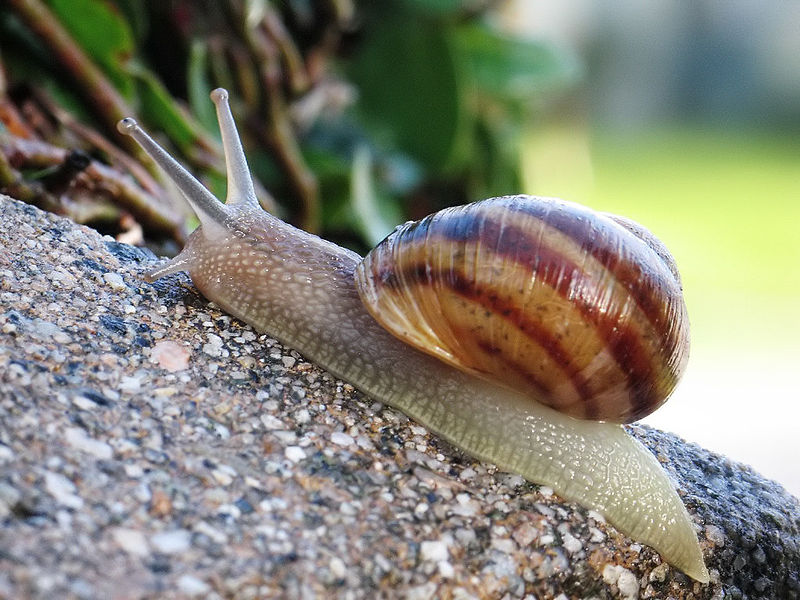
Insects and meat should constitute at least 40% of your blue tongue skink’s diet. Thus, you need to know what insects to feed your blue tongue skinks. Blue tongue skinks consume almost all insects. However, some do not have nutritional value.
For these reasons, it is critical to understand the best insects to feed your BTS. And, which insects to add supplements to make up for the missing nutrients.
You should feed your blue tongue skinks with live insects. Also, it is worth noting that insects from the wild could be harmful to your skink.
Feed the artificially grown insects to your blue tongue skink to prevent the toxicity due to insecticides and pesticides.
New to blue tongue skink? Check out the blue tongue skink care sheet now! We had listed out all the things you need to know about blue tongue skinks as pets. Check it now!
Wild insects could have been sprayed with insecticides, which could be harmful. Therefore, it is best to buy insects from a pet shop or reptile food supply store.
Here is a table showing some of the best insects or sources of proteins.
| To feed frequently | ||||
| Name | Ratio Ca:P | Protein % | Fat% | Notes |
| Cockroach | Good feeder. | |||
| Earthworm | 11.7 | 1.6 | Good feeder | |
| Hornworm | ||||
| Silkworm | 1:3 | 54.7 | 43.0 | Great Feeder |
| Snails | Great feeder. Shells good source of calcium | |||
| To feed in moderate | ||||
| Butter worms | 16.2 | 5.2 | High in calcium | |
| Beef-lean ground | ||||
| Chicken breast (cooked) | Best boiled | |||
| Chicken liver/heart (cooked | Best boiled | |||
| Egg | 1:3.4 | 12.6 | 10.6 | Either raw or boiled |
| Phoenix worm | 1.5:1 | 17.3 | 9.3 | Best for baby and juvenile skinks |
| Superworms | 1:1.8 | 17.4 | 17.9 | High in phosphorus |
| To feed occasionally | ||||
| Cat food (canned) | ||||
| Crickets | Poor nutritional value | |||
| Mealworm | 1:2.5 | 20.3 | 12.7 | |
| Pinky mouse | 1:1 | Low in calcium and high in fats. |
Foodchart source: https://bluetongueskinks.net/foodchart.html
Do They Need To Have Separate Meals?
Blue tongue skinks can be aggressive towards each other. Therefore, it is best if you keep them separate. If you are holding baby blue tongue skinks together, you must use a towel and substrate until their first shedding.
Additionally, blue tongues nutrition needs vary from one age to another. Moreover, baby blue tongue skinks confuse wiggling live worms and insects with their brothers’ and sisters’ feet and nails. Thus, to prevent them from feeding on each other’s legs and nails, you should feed them separately.
Blue Tongue Skink Diet in the Wild
Blue tongue skins are omnivorous. Therefore, they feed on both plants and animals in the wild. Their diet includes; insects, slugs, snails, larvae, and other invertebrates in the wild.
Also, they feed on soft fruits, greens, seeds, and flowers.
Smaller skinks eat small mammals, eggs carrion, and hatchling birds.
In some instances, they feed on herbivore and carnivore dung. Thus, they are also occasionally coprophagous.
In the wild, the blue tongue skinks forage to obtain their food. They will, therefore, feed on what is available at that particular season.
Blue tongue skink diet, however, varies from one species to another. For example, the pygmy blue tongue skink usually feeds on insects and spiders. On the other hand, Triqqua rugosa are known to feed on plants, most of the time. Blue tongue diet should include 40-60% vegetables, 10-20% fruits, and 20-40% insects.
According to a study conducted by Dr. Glenn Shea, when blue tongue skinks feed on plants, they mostly consume seeds and fruits rather than vegetative material.
Also, her study shows that Tilliqua Occipitalis feeds on mollusks in some instances. However, this could be due to mollusks scarcity in arid climates.
Earlier studies had shown that Occipitalis feed on large amounts of arthropods like beetles, plant remains, flowers, and seeds. Rabbit remains were found in one specimen.
Baby Blue Tongue Skink Diet
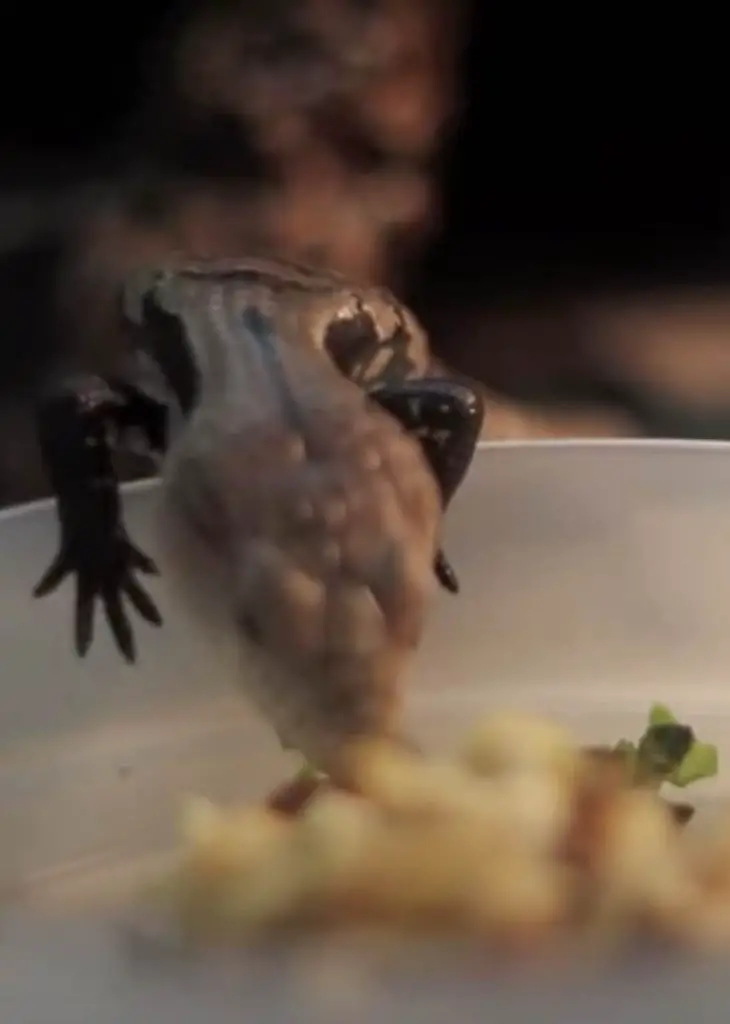
Blue tongue skinks do not need their mother to feed them after they are born. They instantly become independent the minute they are born.
Baby diets are different from their parents for the first couple of weeks. At birth, blue tongue skinks can feed on cat food. Cat food is soft therefore, easy to eat.
But, remember that you have to feed the babies according to their nutritional needs. It is, therefore, critical to plan their diet.
It is also worth noting that nutritional needs are bound to change as they grow. Thus, you should learn how to feed your blue tongue skink at every stage.
Even though this might sound complicated, it is not difficult to feed a blue tongue skink. The general rule on feeding blue tongue skink is, give them food the same size as their head. Thus, you should supply a baby blue tongue skink 1-2 tablespoons per meal.
You should feed baby blue tongue skinks daily until they are three months old. The food should consist of meat, insects, vegetables, and fruits.
How Much They Eat?
The nutritional needs of blue tongue skinks change at every stage. Therefore, the percentage of proteins, fat, and vitamins also changes at every step.
Meat
Meat and insects are good sources of protein. A baby blue tongue skink below three months requires more protein compared to when they are older.
Lack of enough proteins in baby blue tongue diet can cause a scale deformity known as pyramiding.
So, just how much meat should you feed a baby blue tongue skink? A baby blue tongue skink requires 70-80% of proteins on each meal.
Vet advice: You should feed the meat that is high in proteins and contain low fats. As baby skink is growing, it needs enough protein to grow its skeletal system and body tissues. You feed the certain worms that are high in protein.
Vegetables
Vegetables are an essential part of a baby blue tongue skink. They are good sources of vitamins, calcium, and phosphorus.
A baby blue tongue skink requires 20-30% of vegetables. You should use a food processor to blend the baby blue tongue skink vegetables.
Don’t forget to check the best vegetables for BTS and always check for the plants containing toxins. Toxic vegetables can be harmful to them.
While feeding vegetables to baby skin, it is necessary to remove, clean, and feed the vegetables that are beneficial and free from toxins. Because the digestive system of the baby skink is susceptible to minor level of toxins, insecticides, and pesticides.
Fruits
Fruits are also vital for your baby blue tongue skinks. Just like human babies, blue tongue skinks require fruits to build the immune system.
A baby blue tongue skink requires 10% of fruits in their diet.
How Often They Eat
Babies need to eat regularly for them to grow. Therefore, you should feed your baby blue tongue every day.
You can feed your baby blue tongue skinks as much food as they need, preferably 2-3 times a day. It is good to have a feeding schedule for your baby blue tongue skink.
The best time to feed them is 2-3 hours after they wake up. Blue tongue skinks have a slow digestive system, and hence early feeding will help digest the food properly.
Calcium and Vitamins for this Stage
There are two significant supplements in blue tongue skink diet, calcium, and vitamins. When a baby-blue tongue skink feeds on proteins, vegetables, and fruits, in most, you don’t have to add supplements.
However, if you are not sure if the food you are feeding them contains enough calcium and vitamins, you should brush up with supplements.
There are two varieties of calcium: calcium + D3 and pure calcium. While calcium is vital in baby blue tongue skink to strengthen the bones, D3 is responsible for making calcium usable.
D3 can be obtained from sunlight. So, the baby blue tongue skink will only need D3 supplements if it’s not getting enough direct sunlight. UVB lighting can also provide D3, but it might be sufficient.
Multivitamins supplements are responsible for ensuring that the blue tongue skink does not miss any important vitamins in its diet. Therefore, even though you think that you are feeding your baby blue tongue skink with the right food, it is critical to add vitamin supplements.
You don’t have to add vitamin supplements in every single meal. You can just add once or twice a week. However, you should ensure that the supplements you add to the baby blue tongue skink diet are reptile-safe.
Calcium and vitamin supplements for reptiles are readily available in the pet store and also on amazon. Click here to buy one of the best baby blue tongue supplements on amazon.
Juvenile Blue Tongue Skink Diet
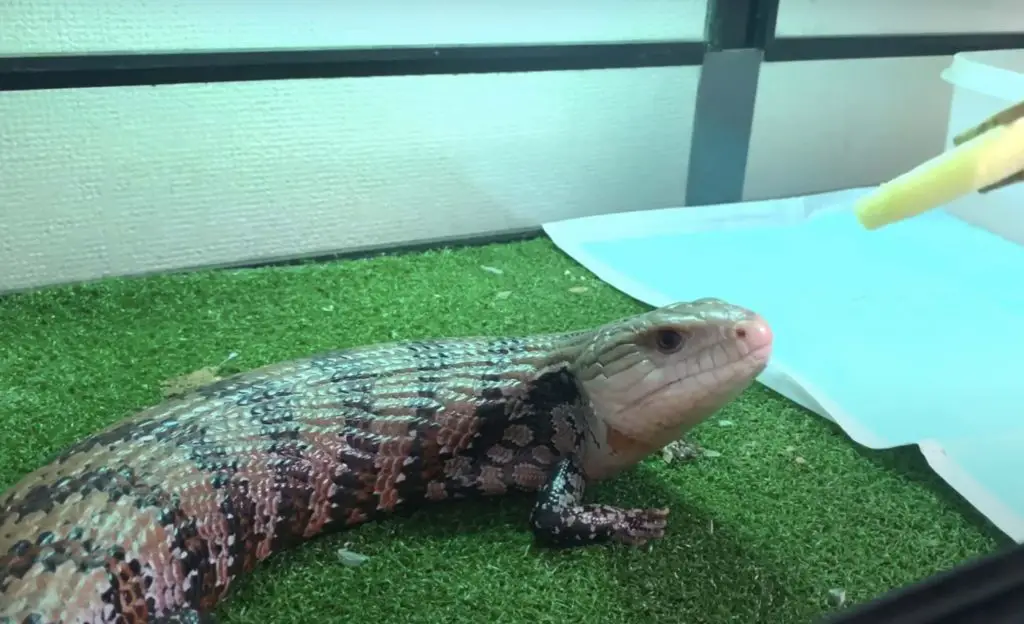
Juvenile blue tongue skinks are range from 3-8 months old. They require proteins in large quantities, just like babies. Juvenile BTS needs 70-80% protein, 20% vegetables, and 10% fruits in their diet.
Therefore, it is critical to plan the juvenile BTS diet well. There are varieties of food to feed juvenile BTS as they feed almost everything that their adults can consume. However, the protein content must be higher than their adult counterparts.
For these reasons, you should be able to analyze the BTS food in terms of nutritional value. Meat and insects are good sources of proteins, while fruits and vegetables are good sources of calcium, phosphorus, and vitamins.
Providing vegetables with meat, supplements, fruits and vitamins is necessary. Because vegetables help to promote healthy digestion and absorption of nutrients from the gut. Some vegetables may have unbalance calcium-phosphorus ratio which prevent the absorption of calcium and other nutrients. So, the vegetables should have low phosphorus and oxalate in them.
How Much They Eat?
Meat
During the juvenile stage of the BTS, feeding them large portions of proteins is critical. Proteins are suitable for the formation of their scales.
Deficiency in protein nutrients can cause scale deformity. Thus, you should ensure their food consists of 70-80% protein.
Also, proteins help BTS to grow fast. Therefore, if you don’t feed your juvenile BTS with enough proteins, they might become underweight or skinny.
Therefore, ensure that 70-80% of your juvenile BTS skink consists of meat and insects. Refer to the previous feed chart to see insects with the highest content of proteins.
Vegetables
Even though juvenile BTS only require a small percentage of plants, they are a significant part of their diet. Lack of enough vegetables can cause vitamin and calcium deficiency in BTS.
Vegetables are good sources of calcium, phosphorus, and vitamins. However, some plants are higher in phosphorus than calcium. Therefore, you should check from the previous table to see which vegetables to feed your BTS frequently and which to feed occasionally.
So, how much of vegetables should you feed your juvenile blue tongue skinks? The best % to feed juvenile BTS is 20%.
You should prepare the fresh vegetables using a food processor or by finely chopping them.
Fruits
Juvenile blue tongue skinks only require a small amount of fruits. Blue tongue skinks can be picky about food. Hence, you should give them a variety of fruits until you know their favourite.
Additionally, it is worth noting that just like vegetables, some fruits are higher in phosphorus than calcium, which is terrible for the reptile. The best ratio for Ca:P should be 2:1. High phosphorus can block calcium.
For the best fruits to feed your juvenile skink, refer to the previous fruit chart. Remember that juveniles require only 10% of fruits in their diet.
How Often They Eat?
You should feed juvenile BTS at least four times a week. But, if your young skinks seem to be skinny or underweight, you can feed them every day. And, if they look chubby or overweight, you can feed them three times a week.
Also, for chubby or overweight juvenile skinks, you can consider reducing the amount of protein intake with vegetables and fruits.
Even so, overweight juvenile BTS are not in as much danger as their adults. Hence, don’t be so strict with their diet.
Moreover, if you feed your juvenile BTS only three times a week and have the right diet, they are less likely to be overweight.
You can tell if the juvenile blue skink is chubby by looking at their tail, belly, and jowls. BTS skinks get fat at the tail, abdomen, and jaws.
A skinny juvenile BTS is bonny at the hips, neck, and legs.
Calcium, Vitamins for the Stage
Healthy feeding might not be enough to provide juveniles with sufficient calcium and vitamins. Therefore, it is necessary to add calcium and vitamin supplements to their diet.
Many reptile owners argue that if you feed your juvenile with a balanced diet, you don’t have to add supplements. Even though this might be correct, extra calcium or vitamins do not have any adverse effects on reptiles. Therefore, it is useful if you would add a little calcium and vitamin supplements in their diet.
Also, if the juvenile BTS is not getting enough vitamin D3 from the UVB lighting, a little vitamin D3 in their diet will come in handy.
You should approximately offer juveniles with calcium and vitamins at least once a week.
New to blue tongue skink? Check out the blue tongue skink care sheet now! We had listed out all the things you need to know about blue tongue skinks as pets. Check it now!
Adult Blue Tongue Skink Diet
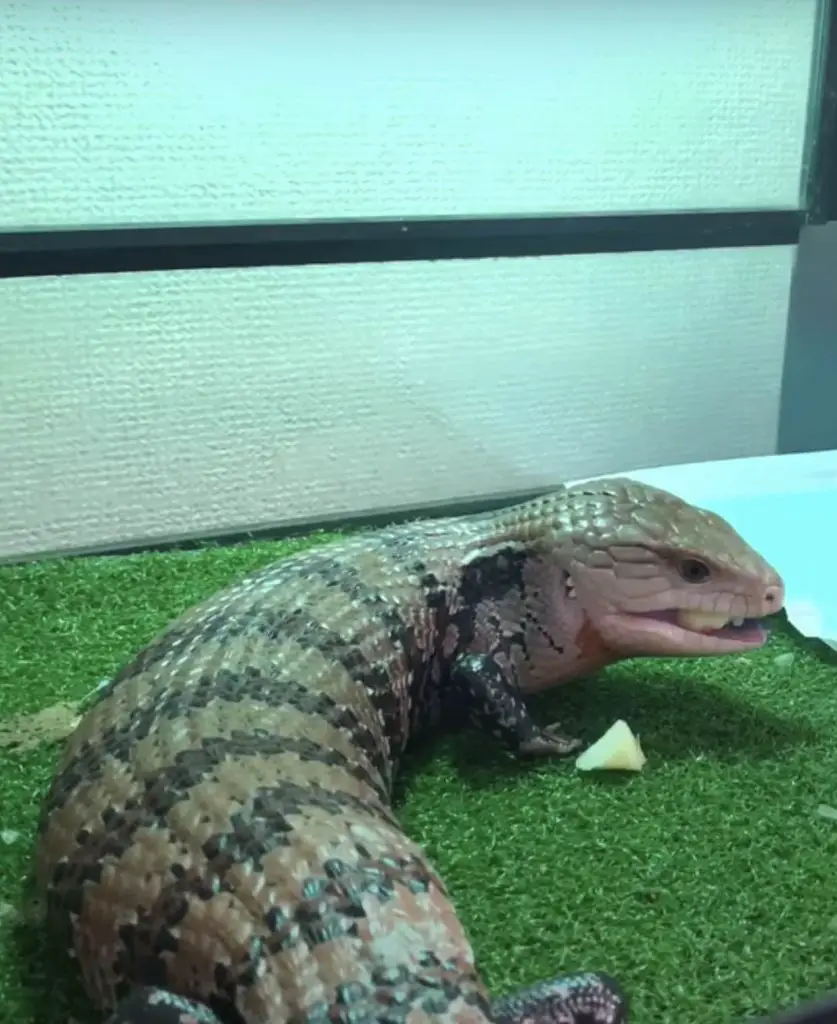
Even though most people consider blue tongue skinks above eight months as adults, the best time to treat them as adults is when they reach two years.
Blue tongue skink’s diet completely changes when they become adults. They no longer need a large portion of proteins. Instead, you increase their vegetable intake and cut down on protein.
Most pet owners feed their adult BTS with dog food. Dog food consists of more vegetables and fewer proteins, which is the best requirement for the adult BTS diet. To make the dog food fit for the adult BTS, you should mix it with fresh vegetables and fruits.
Also, don’t feed adults as often as the young ones. Adult BTS only requires feeding once every two days.
A balanced diet should be given to adults to maintain their health status. They do not need high protein and fat food. However, you can add supplements and vitamins to boost the immune system to prevent diseases and infections.
How Much They Eat?
The ratio of protein to vegetable changes for adult blue tongue skinks. They now require only 50-60% of proteins.
Excessive proteins in the adult diet can cause obesity. Obesity is common in adult BTS and in extreme measures; obesity can cause kidney failure.
It is, therefore, better to give the adults-only the required amount of proteins. Meat and insects are the best sources of proteins.
Meat
So, how much meat and insects should you feed an adult blue tongue skink? You should feed adult blue tongue skink a diet consisting of 50-60% meat and insects.
Not all insects are good sources of proteins. Blue tongue skinks like crickets, even though they have no nutritional value. Others like silkworm have a high amount of protein; thus, you can feed the reptile silkworms frequently.
Chicken breast, liver, and heart are also good food for adult BTS. Refer back to the BTS feed chart above for more on the best meat to feed your BTS.
Vegetables
For adult BTS, plants become a critical nutrient. There are varieties of vegetables to feed the adults. Some skinks like adult shingle back require 70-80% of vegetables in their diet. However, blue tongue skinks require 40-50% of vegetables.
What vegetables should you feed the adult blue tongue skinks?
Some plants are nutritious, while others are toxic. Therefore, you should only be feeding them the best vegetables. The best herbs for skinks are most dark leaf plants like; grape leaves, turnip greens, mulberry leaves, carrot greens, dandelion greens, among others.
Fruits
At this stage, fruit requirements do not change at all. It remains at 10% for all stages in a BTS. Even so, fruits are essential in a BTS diet.
The most crucial factor to remember about fruits in a BTS diet is to check the ratio of Ca:P. fruits that are high in calcium rather than phosphorus are the best to feed frequently.
Also, remember to feed BTS fruits only as a treat, preferably once a week.
How Often They Eat
Unlike baby and juvenile BTS, adults should feed only three times a week. The amount of food per meal should be the same size as their head.
The food should consist of 50% proteins, 40% vegetables, and 10% fruits. However, you should ensure that there is enough fresh, clean water for your BTS daily.
Additionally, if the adult BTS is overweight, you should reduce proteins in their diet and increase vegetables.
Calcium and Vitamins for the Stage
Calcium and vitamins are crucial in the BTS diet at every stage. Thus, you should lightly brush your BTS diet with calcium and multivitamin supplements. However, the supplements should be free from vitamin D and phosphorus.
Vitamin D can be toxic to BTS, and phosphorus can block calcium in their bodies.
Also, you can consider gut loading the insects before feeding them to your BTS. Gut loaded insects are rich in calcium. Therefore, you don’t have to give them calcium supplements.
You can also give your BTS a separate vitamin supplement once a week.
Blue Tongue Skink by Age
Blue tongue skinks go through 3 stages in their lives.
- Baby stage (0-3 months)
- Juvenile stage (3-8 months )
- Adult stage (8 and above months)
Baby and Juvenile Stage
The best food to offer baby BTS is cat food. Cat food contains high amounts of animal proteins and fewer vegetables. Young BTS requires more proteins, approximately 70-80% in their diet, and 20-30% vegetables.
The second thing to add to your young BTS diet is vegetables. Cat food contains proteins but few vegetables. Therefore, to make up for the 30% required for the young BTS, you need to add plants in their diet.
The third nutrient is fruit. All skinks need at least 10% of fruit to be healthy. Hence offering your BTS a fruit treat once a week is necessary.
Adult Blue Tongue Skink
The best food to offer adult BTS is dog food, meat, insects, vegetables, and fruits. Dog food contains proteins and vegetables. Adult BTS requires 50% proteins, 40% vegetables, and 10% fruits.
However, dog food is not enough for adult BTS. Therefore, you should add meat, insects, and vegetables. There are varieties of protein food to feed an adult BTS. These include; chicken, eggs, duck, rabbit, lamb and others
Meat
The best way to prepare meat for your BTS is by;
- Boil
- Freeze it a day before feeding
- Remove it from the freezer 15-20 minutes before feeding.
- Put it in a plastic bag
- Dip it in hot water.
- Offer it to your BTS when reaching 98-1000F
How to Transition a Blue Tongue Skink to a New Diet
Transitioning a BTS to a new diet can be difficult. When they love one food, it’s not easy to make them accept another. However, it is necessary to introduce them to a new diet.
What’s healthy for young BTS might not be enough when they are older. Therefore, at one time or another, you will have to introduce a new diet for them.
BTSs are picky about food, and they can stay for days without eating. Thus, it is difficult to force them to have a meal they don’t like.
How then can you transition them to a new diet?
According to Blue tongue skinks org. the best way to transition them to adult food is by adding baby fruit puree. So, when you introduce your BTS to a new diet and they refuse to eat, add some fruit puree to make the food favourable for them.
The method seems to have worked for many blue tongue skinks keepers.
Feeding a blue tongue skinks a variety of foods can help you to easily introduce a new food to skinks easily and without inducing stress. However, slowly introduce a new diets to the skinks with a few of their favorite snacks.
What Not to Feed Your Blue Tongue Skink
Blue tongue skinks are hardy and can survive almost on any diet. However, it is important to feed them with healthy food.
Proteins, vegetables, and fruits are the primary diets that BTS needs. There are varieties of food to feed them, from protein-rich food to calcium and vitamin-rich food.
But, not all foods are suitable for feeding BTS. Some contain toxins that can be harmful to them.
So, which food contains harmful toxins for BTS? Here is a list of food that you should never feed your BTS;
- Buttercup flowers
- Avocado
- Eggplant
- Lily of the valley
- Onion
- Azalea flowers/leaves
- Tulips
- Daffodil flowers, marijuana
- Hemp leaves
- Potatoes
- Rhubarb
- Buttercups
- Ham
- Mushrooms
- Nuts
- Oranges
- Pasta
- Peanut butter
- Parsley
Wrapping Up Blue Tongue Skink Diet
BTS health is a result of a proper diet. Therefore, if you want to minimize the number of visits to your BTS vet, you should be careful about their diet.
If you want to feed your BTS with a cat or dog food, you should choose a grain-free diet, have a few ingredient lists, and an animal meal/byproduct. Food that contains whole food such as meat, bones, and organs is the best. Raw dog food diets are the best.
Also, it is critical to note that BTS needs fresh water throughout the day. Therefore, you should ensure that there is clean water with a bowl that is no deeper than 3″ for easy access.
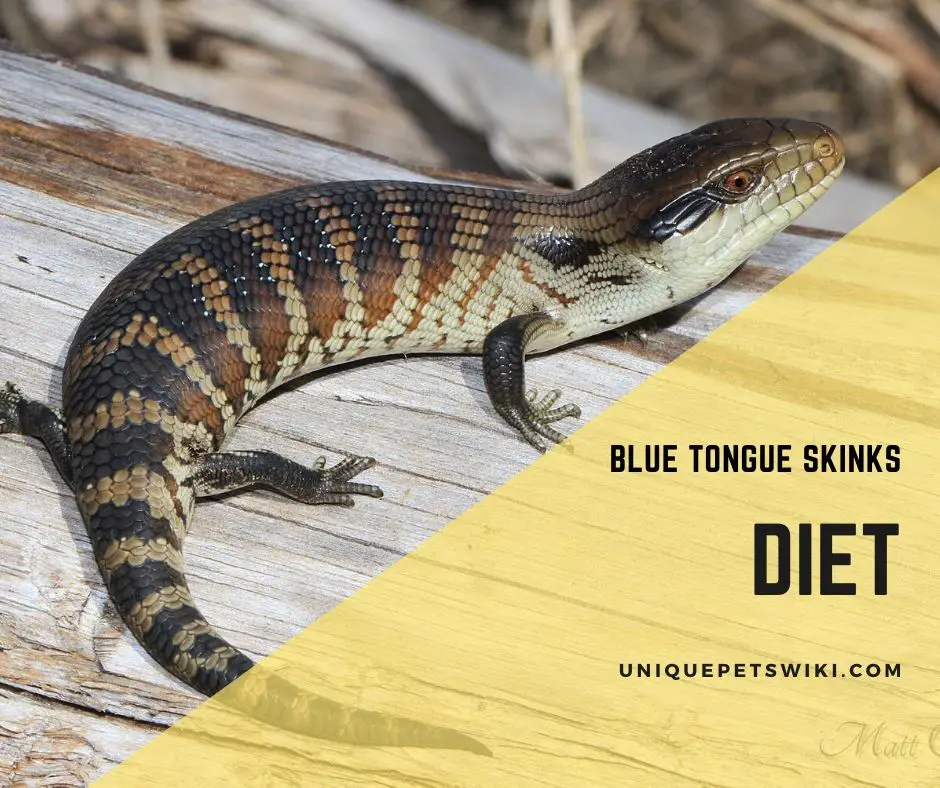
Can you please provide your sources on the charts you used with the nutritional info?
Hi Jay, you can have a look at this:
https://bluetongueskinks.net/foodchart.html
Do blue tongue skinks eat chicken eggs I have one in my yard and was told they do